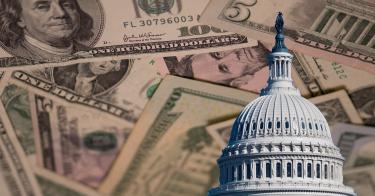As members of Congress debate the debt limit, some seem to think the government has an American Express “Black Card.”
In a 2018 episode of “Comedians in Cars Getting Coffee,” Jerry Seinfeld explained his version of how the Black Card came to be:
“I was waiting for [the crew] to move some cameras, and the crew guy comes up to me, he says, ‘You got the Black Card?’ And I go, ‘No, what’s the Black Card?’ He says, ‘There’s only three in the world. The Sultan of Brunei has one, the president of American Express has one, and I thought you would have the third one.’ Next morning, I call the president of American Express. I go, ‘Is there a Black Card?’ He says, ‘It’s just a rumor. It doesn’t exist.’ He said, ‘But you know what? It’s not a bad idea.’ And so they developed it, and they gave me the first one.”
The so-called Black Card—formally, the Centurian Card—is an exclusive, “no spending limit” credit card, available by invite only. While other companies also have their own versions of “no spending limit” credit cards, the reality is that none offers a blank check on spending.
>>> 18 Absurdities of the McConnell-Schumer Omnibus Spending Bill
The cards may have no preset spending limit, but they all limit cardholders’ purchasing power based on a rolling assessment of their credit worthiness and ability to repay.
And that makes sense because neither the Sultan of Brunei, nor Jerry Seinfeld, nor American politicians should be given a limitless line of credit.
America’s debt limit exists as checkpoint, meant to protect Americans from the reckless accumulation of debt in their names, and that of their children and grandchildren. That’s why a majority of Americans oppose raising the debt limit unless policymakers also reduce spending.
Already, the U.S. has accumulated $31.4 trillion in federal debt—the equivalent of $242,000 per household.
If the federal government’s borrowing were subject to the same constraints as ordinary households and it actually had to repay its borrowing, every household in America would suddenly have two mortgage or rent payments each month, instead of just one. (At $220,000 in 2021, average mortgage debt was slightly lower than each household’s share of the federal debt).
But unlike ordinary households—and unlike even exclusive Black Card holders—the federal government can simply vote to raise or temporarily waive its debt limits.
Over the past decade, policymakers have frequently given lip service to the debt limit, choosing to “suspend” the debt limit for periods of time, instead of setting dollar limits, and usually failing to include meaningful measures to alter unsustainable federal spending.
The proof is in the pudding in the case against Congress granting itself unlimited spending periods. Over the course of 74 years, from the establishment of the first debt limit in 1939 (an amount equal to $968 billion in today’s dollars) to 2013, policymakers raised the debt limit by about $15.4 trillion.
In 2013, policymakers began the practice of “suspending” the debt limit instead of setting dollar limits and the consequence was $12 trillion in new debt over the following eight years, through 2021. That’s seven times the inflation-adjusted rate of expansion prior to the reckless practice of suspending the debt limit.
And the federal government blew through Democrats’ $2.5 trillion debt limit increase enacted in December 2021, adding $19,200 in debt per household over the past 13 months.
>>> Combat the Inflation Reduction Act’s Central Planning
Imposing an actual debt limit and enacting meaningful spending reforms is crucial because if politicians don’t set their own limits, they’ll face the market’s limits.
At some point, investors will become unwilling to continue lending to the U.S. government at reasonable interest rates, and recent years of reckless spending have pushed us closer to that point. The consequences of a market-imposed federal debt limit will be far more severe than the short-term effects of modest fiscal restraints that should accompany any debt limit increase.
For example, if markets soured on U.S. debt in 2025, balancing the federal budget in that year alone would require policymakers to take an extra $10,000 per household across the U.S.
If, however, policymakers were to agree to meaningful spending reductions and pro-growth policy reforms in exchange for a specified increase in the debt limit, they could help avoid a fiscal crisis and start reducing the second-mortgage equivalent of federal debt that looms over every household in America.
They might even start to get us out of the red—and into the black.
This piece originally appeared in ArcaMax





